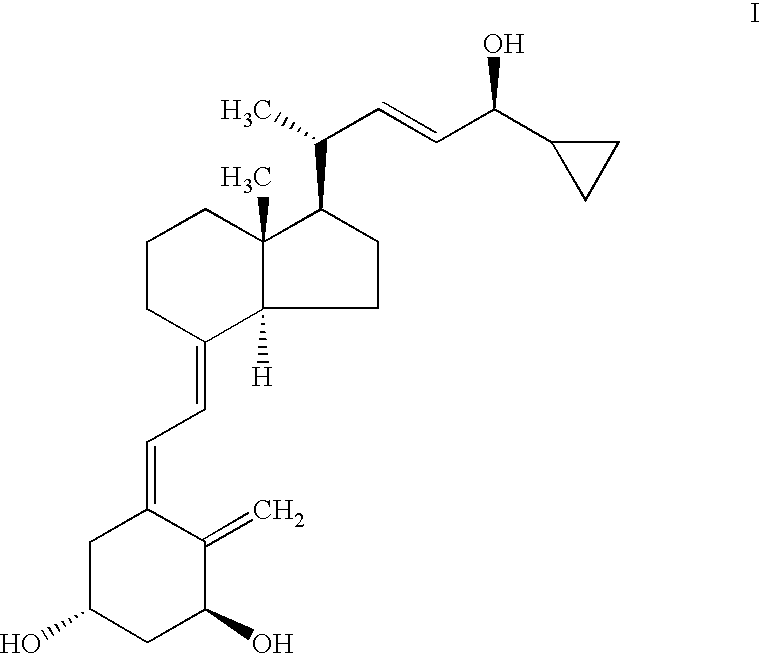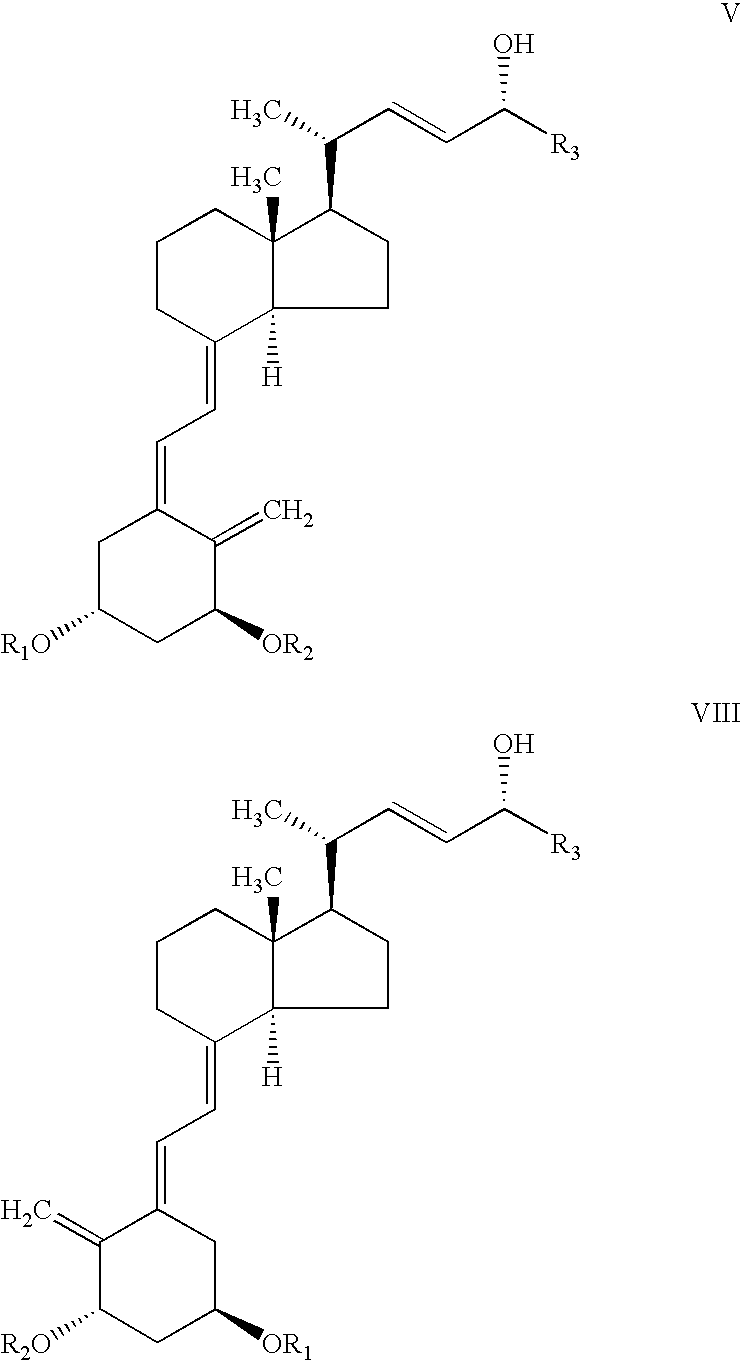Epimerization of analogs of vitamin D
- Summary
- Abstract
- Description
- Claims
- Application Information
AI Technical Summary
Problems solved by technology
Method used
Image
Examples
example 1
One-pot Batch Process on Silica Gel in Hexane
[0041]To a round bottom 250 ml flask containing a solution of acetate IX (R3=cyclopropyl, R2=R3=tert-butyldimethylsilyl (TBDMS), d.e. >97%,7.28 g) in hexane (180 ml), was added silica gel type 60 (0.043–0.060 mm, 71.93 g). The mixture was stirred slowly for 4 hr and then filtered. The silica gel was washed with ethyl acetate (300 ml), followed by a 10% solution of methanol in ethyl acetate. The filtrate and washings were combined and evaporated to dryness at 38° C. / 20 mbar to afford a crude product (6.55 g) containing 79.3% of a mixture of the epimeric alcohols IV (R3=cyclopropyl, R2=R1=TBDMS) with d.e.=9%. The overall yield of IV was 81%.
[0042]Results for the batch epimerization of the acetate IX (R3=cyclopropyl, R2R3=tert-butydimethylsilyl), obtained as above but with shorter reaction time promoted by different types of silica gel in hexane, at various temperatures and silica gel / substrate ratios, are presented in Table 1.
[0043]
TABLE 1R...
example 2
2-Step Batch Process on Silica Gel Following Hydrolysis with K2CO3
[0044]To a round bottom 50 ml flask containing a solution of acetate IX (R3=cyclopropyl, R2=R3=tert-butyldimethylsilyl, TBDMS, d.e. >97%1.02 g) in hexane (20 ml), was added silica gel grade 40 (0.063–0.200 mm, 4.61 g). After stirring for about an hour, the contents of the flask were filtered and the residual silica gel was washed with ethyl acetate (50 ml). The filtrate and washing were combined and evaporated to dryness at 38° C. / 20 mbar to afford a crude product (0.935 g) containing 50.1% of a mixture of acetates X (R3=cyclopropyl, R2=R3=tert-butyldimethylsilyl, TBDMS) with d.e. 7.4%. These were dissolved in Methanol / THF (2.5 ml:2.5 ml), anhydrous potassium carbonate (0.61 g) was added and the mixture was stirred overnight. The solvent was removed under reduced pressure and the residue was extracted with hexane (3×30 ml). The extracts were combined and evaporated to afford 0.873 g of a crude product, containing 76....
example 3
2-Step Batch Process on Alumimum Oxide
[0045]To a round bottom 100 ml flask containing a solution of acetate IX (R3=cyclopropyl, R2=R3=TBDMS, d.e. >97% 2.2 g) in hexane (44 ml), was added basic aluminum oxide (90, 0.063–0.200 23.1 g). After stirring over 6 hours the content was filtered and the residual alumina was then washed with ethyl acetate (80 ml). The filtrate and washing were combined and evaporated to dryness at 38° C. / 20 mbar to afford a crude product (1.97 g) containing 59% of a mixture of acetates X (R3=cyclopropyl, R2=R3=tert-butyldimethylsilyl, TBDMS). The residue was dissolved in Methanol / dichloromethane (3.5 ml:2.5 ml), anhydrous potassium carbonate (1.3 g) was added and the mixture was stirred overnight. The solvent was removed under reduced pressure and the residue was extracted with hexane (2×40 ml). The extracts were combined and evaporated to afford 1.68 g of a crude product, containing 93% of a mixture of alcohols IV with d.e. 69%. Yield 98%.
PUM
 Login to View More
Login to View More Abstract
Description
Claims
Application Information
 Login to View More
Login to View More - R&D
- Intellectual Property
- Life Sciences
- Materials
- Tech Scout
- Unparalleled Data Quality
- Higher Quality Content
- 60% Fewer Hallucinations
Browse by: Latest US Patents, China's latest patents, Technical Efficacy Thesaurus, Application Domain, Technology Topic, Popular Technical Reports.
© 2025 PatSnap. All rights reserved.Legal|Privacy policy|Modern Slavery Act Transparency Statement|Sitemap|About US| Contact US: help@patsnap.com



